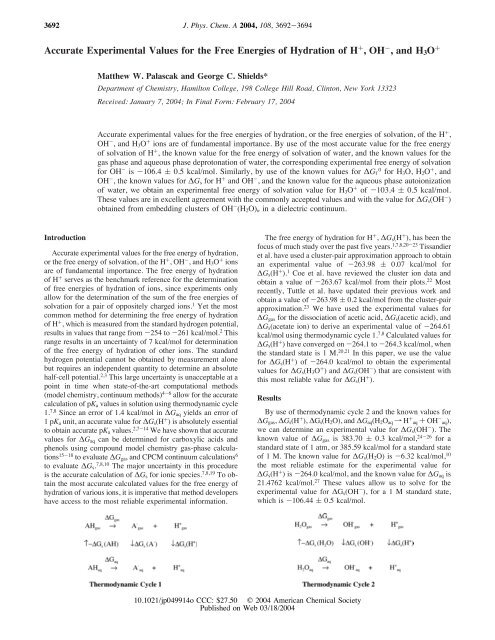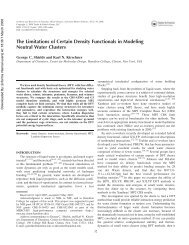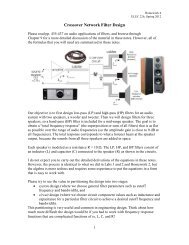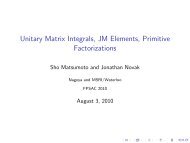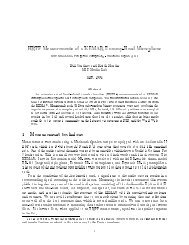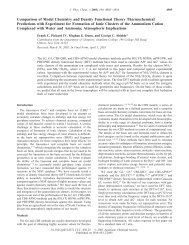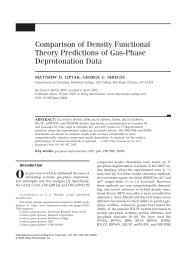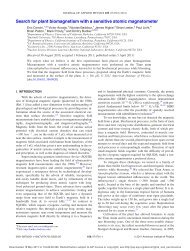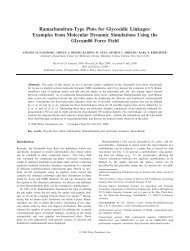Accurate Experimental Values for the Free Energies of Hydration of ...
Accurate Experimental Values for the Free Energies of Hydration of ...
Accurate Experimental Values for the Free Energies of Hydration of ...
You also want an ePaper? Increase the reach of your titles
YUMPU automatically turns print PDFs into web optimized ePapers that Google loves.
3692 J. Phys. Chem. A 2004, 108, 3692-3694<strong>Accurate</strong> <strong>Experimental</strong> <strong>Values</strong> <strong>for</strong> <strong>the</strong> <strong>Free</strong> <strong>Energies</strong> <strong>of</strong> <strong>Hydration</strong> <strong>of</strong> H + , OH - , and H 3 O +Mat<strong>the</strong>w W. Palascak and George C. Shields*Department <strong>of</strong> Chemistry, Hamilton College, 198 College Hill Road, Clinton, New York 13323ReceiVed: January 7, 2004; In Final Form: February 17, 2004<strong>Accurate</strong> experimental values <strong>for</strong> <strong>the</strong> free energies <strong>of</strong> hydration, or <strong>the</strong> free energies <strong>of</strong> solvation, <strong>of</strong> <strong>the</strong> H + ,OH - , and H 3 O + ions are <strong>of</strong> fundamental importance. By use <strong>of</strong> <strong>the</strong> most accurate value <strong>for</strong> <strong>the</strong> free energy<strong>of</strong> solvation <strong>of</strong> H + , <strong>the</strong> known value <strong>for</strong> <strong>the</strong> free energy <strong>of</strong> solvation <strong>of</strong> water, and <strong>the</strong> known values <strong>for</strong> <strong>the</strong>gas phase and aqueous phase deprotonation <strong>of</strong> water, <strong>the</strong> corresponding experimental free energy <strong>of</strong> solvation<strong>for</strong> OH - is -106.4 ( 0.5 kcal/mol. Similarly, by use <strong>of</strong> <strong>the</strong> known values <strong>for</strong> ∆G f 0<strong>for</strong> H 3 O, H 2 O + , andOH - , <strong>the</strong> known values <strong>for</strong> ∆G s <strong>for</strong> H + and OH - , and <strong>the</strong> known value <strong>for</strong> <strong>the</strong> aqueous phase autoionization<strong>of</strong> water, we obtain an experimental free energy <strong>of</strong> solvation value <strong>for</strong> H 3 O + <strong>of</strong> -103.4 ( 0.5 kcal/mol.These values are in excellent agreement with <strong>the</strong> commonly accepted values and with <strong>the</strong> value <strong>for</strong> ∆G s (OH - )obtained from embedding clusters <strong>of</strong> OH - (H 2 O) n in a dielectric continuum.Introduction<strong>Accurate</strong> experimental values <strong>for</strong> <strong>the</strong> free energy <strong>of</strong> hydration,or <strong>the</strong> free energy <strong>of</strong> solvation, <strong>of</strong> <strong>the</strong> H + , OH - , and H 3 O + ionsare <strong>of</strong> fundamental importance. The free energy <strong>of</strong> hydration<strong>of</strong> H + serves as <strong>the</strong> benchmark reference <strong>for</strong> <strong>the</strong> determination<strong>of</strong> free energies <strong>of</strong> hydration <strong>of</strong> ions, since experiments onlyallow <strong>for</strong> <strong>the</strong> determination <strong>of</strong> <strong>the</strong> sum <strong>of</strong> <strong>the</strong> free energies <strong>of</strong>solvation <strong>for</strong> a pair <strong>of</strong> oppositely charged ions. 1 Yet <strong>the</strong> mostcommon method <strong>for</strong> determining <strong>the</strong> free energy <strong>of</strong> hydration<strong>of</strong> H + ,whichismeasuredfrom<strong>the</strong>standardhydrogenpotential,results in values that range from -254 to -261 kcal/mol. 2 Thisrange results in an uncertainty <strong>of</strong> 7 kcal/mol <strong>for</strong> determination<strong>of</strong> <strong>the</strong> free energy <strong>of</strong> hydration <strong>of</strong> o<strong>the</strong>r ions. The standardhydrogen potential cannot be obtained by measurement alonebut requires an independent quantity to determine an absolutehalf-cell potential. 2,3 This large uncertainty is unacceptable at apoint in time when state-<strong>of</strong>-<strong>the</strong>-art computational methods(model chemistry, continuum methods) 4-6 allow <strong>for</strong> <strong>the</strong> accuratecalculation <strong>of</strong> pK a values in solution using <strong>the</strong>rmodynamic cycle1. 7,8 Since an error <strong>of</strong> 1.4 kcal/mol in ∆G aq yields an error <strong>of</strong>1pK a unit, an accurate value <strong>for</strong> ∆G s (H + )isabsolutelyessentialto obtain accurate pK a values. 2,7-14 We have shown that accuratevalues <strong>for</strong> ∆G aq can be determined <strong>for</strong> carboxylic acids andphenols using compound model chemistry gas-phase calculations15-18 to evaluate ∆G gas and CPCM continuum calculations 6to evaluate ∆G s . 7,8,10 The major uncertainty in this procedureis <strong>the</strong> accurate calculation <strong>of</strong> ∆G s <strong>for</strong> ionic species. 7,8,19 To obtain<strong>the</strong> most accurate calculated values <strong>for</strong> <strong>the</strong> free energy <strong>of</strong>hydration <strong>of</strong> various ions, it is imperative that method developershave access to <strong>the</strong> most reliable experimental in<strong>for</strong>mation.The free energy <strong>of</strong> hydration <strong>for</strong> H + , ∆G s (H + ), has been <strong>the</strong>focus <strong>of</strong> much study over <strong>the</strong> past five years. 1,7,8,20-23 Tissandieret al. have used a cluster-pair approximation approach to obtainan experimental value <strong>of</strong> -263.98 ( 0.07 kcal/mol <strong>for</strong>∆G s (H + ). 1 Coe et al. have reviewed <strong>the</strong> cluster ion data andobtain a value <strong>of</strong> -263.67 kcal/mol from <strong>the</strong>ir plots. 22 Mostrecently, Tuttle et al. have updated <strong>the</strong>ir previous work andobtain a value <strong>of</strong> -263.98 ( 0.2 kcal/mol from <strong>the</strong> cluster-pairapproximation. 23 We have used <strong>the</strong> experimental values <strong>for</strong>∆G gas <strong>for</strong> <strong>the</strong> dissociation <strong>of</strong> acetic acid, ∆G s (acetic acid), and∆G s (acetate ion) to derive an experimental value <strong>of</strong> -264.61kcal/mol using <strong>the</strong>rmodynamic cycle 1. 7,8 Calculated values <strong>for</strong>∆G s (H + )haveconvergedon-264.1 to -264.3 kcal/mol, when<strong>the</strong> standard state is 1 M. 20,21 In this paper, we use <strong>the</strong> value<strong>for</strong> ∆G s (H + )<strong>of</strong>-264.0 kcal/mol to obtain <strong>the</strong> experimentalvalues <strong>for</strong> ∆G s (H 3 O + ) and ∆G s (OH - ) that are consistent withthis most reliable value <strong>for</strong> ∆G s (H + ).ResultsBy use <strong>of</strong> <strong>the</strong>rmodynamic cycle 2 and <strong>the</strong> known values <strong>for</strong>∆G gas , ∆G s (H + ), ∆G s (H 2 O), and ∆G aq (H 2 O aq f H + aq + OH - aq),we can determine an experimental value <strong>for</strong> ∆G s (OH - ). Theknown value <strong>of</strong> ∆G gas is 383.70 ( 0.3 kcal/mol, 24-26 <strong>for</strong> astandard state <strong>of</strong> 1 atm, or 385.59 kcal/mol <strong>for</strong> a standard state<strong>of</strong> 1 M. The known value <strong>for</strong> ∆G s (H 2 O) is -6.32 kcal/mol, 10<strong>the</strong> most reliable estimate <strong>for</strong> <strong>the</strong> experimental value <strong>for</strong>∆G s (H + ) is -264.0 kcal/mol, and <strong>the</strong> known value <strong>for</strong> ∆G aq is21.4762 kcal/mol. 27 These values allow us to solve <strong>for</strong> <strong>the</strong>experimental value <strong>for</strong> ∆G s (OH - ), <strong>for</strong> a 1 M standard state,which is -106.44 ( 0.5 kcal/mol.10.1021/jp049914o CCC: $27.50 © 2004 American Chemical SocietyPublished on Web 03/18/2004
<strong>Free</strong> <strong>Energies</strong> <strong>of</strong> <strong>Hydration</strong> <strong>of</strong> H + , OH - , and H 3 O + J. Phys. Chem. A, Vol. 108, No. 16, 2004 3693TABLE 1: <strong>Experimental</strong> <strong>Values</strong> <strong>for</strong> ∆G s (OH - ) and∆G s (H 3 O + ) Consistent with Thermodynamic Cycles 2 and 3and <strong>the</strong> Indicated <strong>Values</strong> <strong>for</strong> ∆G s (H + ) a∆G s(H + ) ∆G s(OH - ) ∆G s(H 3O + )-263.67 -106.77 -103.12-264.0 -106.44 -103.45-264.61 -105.83 -104.06aAll values are in kcal/mol, <strong>for</strong> a standard state <strong>of</strong> 1 M and 298.15K. The best values, based on <strong>the</strong> most accurate experimental determination<strong>of</strong> ∆G s(H + ), are in bold, with an estimated uncertainty <strong>of</strong> (0.5kcal/mol.Similarly, we use <strong>the</strong>rmodynamic cycle 3 to solve <strong>for</strong>∆G s (H 3 O + ). In this case, we determine ∆G gas using <strong>the</strong> standardGibbs free energies <strong>of</strong> <strong>for</strong>mations, ∆G f 0 , <strong>for</strong> H 2 O(-54.6324kcal/mol), H 3 O + (144.9843 kcal/mol), and OH - (-33.1496 kcal/mol). 28 For <strong>the</strong>rmodynamic cycle 3, we have that ∆G gas )221.0995 kcal/mol <strong>for</strong> a standard state <strong>of</strong> 1 atm and <strong>for</strong> astandard state <strong>of</strong> 1 M, since ∆n gas equals zero. From K w and<strong>the</strong> concentration <strong>of</strong> water at 298.15 K, [H 2 O] ) 55.34 M, wehave ∆G aq ) 23.8541 kcal/mol. By use <strong>of</strong> a value <strong>of</strong> ∆G s (H + )<strong>of</strong> -264.0 and a value <strong>for</strong> ∆G s (OH - ) <strong>of</strong> -106.44 kcal/mol, wederive a value <strong>for</strong> ∆G s (H 3 O + ) <strong>of</strong> -103.45 kcal/mol. Table 1summarizes <strong>the</strong> values <strong>of</strong> ∆G s (OH - ) and ∆G s (H 3 O + ) obtainedfrom various values <strong>of</strong> ∆G s (H + ).DiscussionBecause ∆G s (H + ) is a number close to -264 kcal/mol,∆G s (OH - ) must be close to -106.4 kcal/mol, and ∆G s (H 3 O + )must be close to -103.4 kcal/mol (Table 1). On <strong>the</strong> basis <strong>of</strong><strong>the</strong> agreement between experimental and <strong>the</strong>oretical approaches<strong>for</strong> determining ∆G s (H + ), we estimate error bars on <strong>the</strong> numberslisted in boldface type in Table 1 <strong>of</strong> (0.5 kcal/mol. With <strong>the</strong>sevalues in hand, we can evaluate <strong>the</strong> values reported in <strong>the</strong>literature <strong>for</strong> ∆G s (OH - ) and ∆G s (H 3 O + ).Zhan and Dixon have used clusters <strong>of</strong> OH - (H 2 O) n embeddedin a dielectric continuum to calculate a value <strong>of</strong> ∆G s (OH - ) <strong>of</strong>-104.5 kcal/mol, <strong>for</strong> a standard state <strong>of</strong> 1 M. 29 Our predictionis in excellent agreement with <strong>the</strong>ir prior calculation. Pliegoand Riveros have used Monte Carlo simulations and free-energypertubation to estimate <strong>the</strong> absolute free energy <strong>of</strong> hydration <strong>of</strong>OH - in aqueous solution to be -108.0 kcal/mol. 30 Pliego hasalso used Tissandier’s value <strong>of</strong> -264.0 kcal/mol <strong>for</strong> ∆G s (H + ) 1and a combination <strong>of</strong> experimental and <strong>the</strong>oretical values <strong>for</strong>proton affinities, aqueous acidity constants, and solvation freeenergies <strong>of</strong> neutral species, to calculate a value <strong>for</strong> ∆G s (OH - )<strong>of</strong> -105.0 kcal/mol. 31 This value is 1.4 kcal/mol more positivethan our estimate, a result stemming from <strong>the</strong> approximationthat <strong>the</strong> gas-phase proton affinities <strong>of</strong> all negatively chargedspecies have constant entropy terms (T∆S) equal to 7.5 kcal/mol. 32-34 Mejías and Lago have calculated <strong>the</strong> value <strong>for</strong>∆G s (H + ) and ∆G s (OH - ) using a combination <strong>of</strong> DFT and apolarizable continuum model. 35 Their results <strong>for</strong> ∆G s (H + ),-274.9 kcal/mol, appear to be relatively inaccurate given <strong>the</strong>convergence <strong>of</strong> o<strong>the</strong>r computed numbers with similar procedures,20,21 and <strong>the</strong> most reliable available experimental results.1,22,23 Similarly, <strong>the</strong> value obtained <strong>for</strong> ∆G s (OH - ), -95.6kcal/mol, is again <strong>of</strong>f by 10 kcal/mol. 35 The authors speculatethat <strong>the</strong>ir method is not suitable <strong>for</strong> a highly accurate determination<strong>of</strong> entropic effects, as <strong>the</strong>ir values <strong>for</strong> ∆H s are in betteragreement with experiment. 35Our results predict a range <strong>for</strong> <strong>the</strong> value <strong>for</strong> ∆G s (H 3 O + ) <strong>of</strong>-103 to -104 kcal/mol, with <strong>the</strong> best estimate being -103.4kcal/mol. Pliego and Riveros have determined ∆G s (H 3 O + )froma three-step process: vaporization <strong>of</strong> water, <strong>for</strong>mation <strong>of</strong> <strong>the</strong>H 3 O + ion in <strong>the</strong> gas phase, and solvation <strong>of</strong> <strong>the</strong> H 3 O + species.They use <strong>the</strong> equation ∆G s (H 3 O + ) ) ∆G s (H + ) + ∆G 0 bas(H 2 O)+ ∆G vap (H 2 O). They use <strong>the</strong> best experimental value <strong>for</strong>∆G s (H + ), -264.0 kcal/mol, a value <strong>of</strong> 155.6 kcal/mol <strong>for</strong>∆G 0 bas(H 2 O), and a value <strong>of</strong> 2.0 kcal/mol <strong>for</strong> ∆G vap (H 2 O). 31The value <strong>for</strong> ∆G 0 bas(H 2 O) was determined from <strong>the</strong> approximaterelationship, ∆G 0 bas ≈ ∆H 0 PA - 7.5 kcal/mol, using<strong>the</strong> experimental value <strong>of</strong> 165.0 ( 0.5 kcal/mol <strong>for</strong> <strong>the</strong> protonaffinity. 36 We believe that most <strong>of</strong> <strong>the</strong> 7 kcal/mol discrepancybetween Pliego and Riveros’ value <strong>of</strong> -110.4 and our value <strong>of</strong>-103.4 is attributable to inconsistencies in standard states and<strong>the</strong>ir value <strong>of</strong> 155.6 kcal/mol <strong>for</strong> <strong>the</strong> basicity <strong>of</strong> water.We can estimate an accurate value <strong>for</strong> <strong>the</strong> basicity <strong>of</strong> waterusing <strong>the</strong> complete basis set atomic-pair natural orbital (CBS-APNO) method. 37,38 By use <strong>of</strong> CBS-APNO calculations <strong>for</strong>H 3 O + and H 2 O, we obtain absolute free energies <strong>of</strong> -76.428190and -76.690657 Hartrees at 298.15 K. By use <strong>of</strong> G gas (H + ) )-6.28 kcal/mol, 7,8 we obtain a ∆G gas <strong>of</strong> -158.4 kcal/mol <strong>for</strong> astandard state <strong>of</strong> 1 atm. Converting to a standard state <strong>of</strong> 1 Myields -160.3 kcal/mol, which differs from <strong>the</strong> Pliego value<strong>for</strong> <strong>the</strong> basicity <strong>of</strong> water by 5 kcal/mol. Using <strong>the</strong> CBS-APNOcalculated value <strong>of</strong> -160.3 yields a value <strong>of</strong> -105.7 kcal/mol<strong>for</strong> ∆G s (H 3 O + ). Thus <strong>the</strong> CBS-APNO value is 2.3 kcal/molmore negative than <strong>the</strong> best estimate using <strong>the</strong> best availableexperimental numbers (Table 1) but is still 5 kcal/mol morepositive than <strong>the</strong> calculated value <strong>of</strong> Pliego and Riveros.It has been previously demonstrated that <strong>the</strong> value <strong>of</strong> 2.0 kcal/mol <strong>for</strong> <strong>the</strong> vaporization <strong>of</strong> water represents <strong>the</strong> transition <strong>of</strong>liquid water in <strong>the</strong> reference state <strong>of</strong> 55.34 M, 298.15 K togaseous water in <strong>the</strong> reference state <strong>of</strong> 1 atm, 298.15 K. 10 As<strong>the</strong> relationship between intermolecular interactions and freeenergies <strong>of</strong> transfer between phases is most direct when using<strong>the</strong> same standard concentration <strong>for</strong> both phases, <strong>the</strong> usualreference state is1Mat<strong>the</strong>given temperature. 39 Thus <strong>the</strong> value<strong>of</strong> 2.0 kcal/mol <strong>for</strong> <strong>the</strong> vaporization <strong>of</strong> 55.34 M water at 298.15K to 1 atm gaseous water is equivalent to 6.32 kcal/mol whenboth <strong>the</strong> water and gas standard states are 1 M. 10 This idea hasbeen recognized by Pliego in a recent paper, where <strong>the</strong> validity<strong>of</strong> our calculation <strong>of</strong> standard states 10 has been affirmed. 32The usual quoted experimental values <strong>for</strong> ∆G s (OH - )and∆G s (H 3 O + )are-106 and -104 kcal/mol, respectively. 31,40 Ourvalues provide a slight correction and are within half a kcal/mol <strong>of</strong> <strong>the</strong> usual numbers. We note that <strong>the</strong>se numbers aregenerally not believed to be very accurate, given <strong>the</strong> assumptionsmade in <strong>the</strong>ir derivation and <strong>the</strong> previously mentioned difficultiesin assigning <strong>the</strong> value <strong>for</strong> ∆G s (H + ) from <strong>the</strong> standardhydrogen potential. In fact, <strong>the</strong> range <strong>of</strong> reported experimentalvalues <strong>for</strong> ∆G s (OH - )isextremelywide,from-90.6 to -110.0kcal/mol. 35,41,42 This un<strong>for</strong>tunate situation makes it difficult <strong>for</strong>scientists to assess <strong>the</strong>ir own work when using <strong>the</strong>se values. Itis reassuring that <strong>the</strong> most widely quoted values are in agreementwith our more accurate determinations presented in this paper.
3694 J. Phys. Chem. A, Vol. 108, No. 16, 2004 Palascak and ShieldsConclusionWe have shown that, by use <strong>of</strong> <strong>the</strong> most accurate value <strong>for</strong><strong>the</strong> free energy <strong>of</strong> solvation <strong>of</strong> H + , -264.0 kcal/mol, <strong>the</strong> knownvalue <strong>for</strong> <strong>the</strong> free energy <strong>of</strong> solvation <strong>of</strong> water, -6.32 kcal/mol, and <strong>the</strong> known values <strong>for</strong> <strong>the</strong> gas-phase and aqueous-phasedeprotonation <strong>of</strong> water, <strong>the</strong> corresponding experimental freeenergy <strong>of</strong> solvation <strong>for</strong> OH - is -106.4 kcal/mol. Similarly, byuse <strong>of</strong> <strong>the</strong> known values <strong>for</strong> ∆G f 0 <strong>for</strong> H 2 O, H 3 O + , and OH - ,<strong>the</strong> values <strong>for</strong> ∆G s <strong>for</strong> H + , OH - , and H 2 O, and ∆G aq <strong>for</strong> <strong>the</strong>dissociation <strong>of</strong> water into OH - aq and H 3 O + aq, we obtain anexperimental free energy <strong>of</strong> solvation value <strong>for</strong> H 3 O + <strong>of</strong> -103.4kcal/mol. These values are in excellent agreement with <strong>the</strong>commonly accepted values 40 and with <strong>the</strong> value <strong>for</strong> ∆G s (OH - )obtained from embedding clusters <strong>of</strong> OH - (H 2 O) n in a dielectriccontinuum. 29 These accurate experimental values <strong>for</strong> ∆G s (H + ),∆G s (OH - ), and ∆G s (H 3 O + ), <strong>for</strong> <strong>the</strong> standard state <strong>of</strong> 1 M and298.15 K, can now be used to reevaluate values <strong>of</strong> ∆G s <strong>for</strong> all<strong>of</strong> <strong>the</strong> anions and cations reported in <strong>the</strong> literature. In addition,<strong>the</strong>se values can be used with confidence <strong>for</strong> assessing <strong>the</strong> ability<strong>of</strong> various computational methods to reproduce <strong>the</strong> free energy<strong>of</strong> solvation <strong>of</strong> <strong>the</strong>se important ions.Acknowledgment. Acknowledgment is made to <strong>the</strong> donors<strong>of</strong> <strong>the</strong> Petroleum Research Fund, administered by <strong>the</strong> AmericanChemical Society, to <strong>the</strong> NIH, to <strong>the</strong> Dreyfus Foundation, andto Hamilton College <strong>for</strong> support <strong>of</strong> this work. This projectwas supported in part by NSF Grant CHE-0116435 as part<strong>of</strong> <strong>the</strong> MERCURY supercomputer consortium (http://mars.hamilton.edu). M.W.P acknowledges support from <strong>the</strong> Camille& Henry Dreyfus Foundation.References and Notes(1) Tissandier, M. D.; Cowen, K. A.; Feng, W. Y.; Gundlach, E.;Cohen, M. H.; Earhart, A. D.; Coe, J. V.; Tuttle, T. R. J. Phys. Chem. A1998, 102, 7787-7794.(2) Lim, C.; Bash<strong>for</strong>d, D.; Karplus, M. J. Phys. Chem. 1991, 95,5610-5620.(3) Reiss, H.; Heller, A. J. Phys. Chem. 1985, 89, 4207-4213.(4) Ochterski, J. W.; Petersson, G. A.; Wiberg, K. B. J. Am. Chem.Soc. 1995, 117, 11299-11308.(5) Pople, J. A. Angew. Chem., Int. Ed. 1999, 38, 1894-1902.(6) Barone, V.; Cossi, M. J. Phys. Chem. A 1998, 102, 1995-2001.(7) Liptak, M. D.; Shields, G. C. J. Am. Chem. Soc. 2001, 123, 7314-7319.(8) Liptak, M. D.; Gross, K. C.; Seybold, P. G.; Feldgus, S.; Shields,G. C. J. Am. Chem. Soc. 2002, 124, 6421-6427.(9) Toth, A. M.; Liptak, M. D.; Phillips, D. L.; Shields, G. C. J. Chem.Phys. 2001, 114, 4595-4606.(10) Liptak, M. D.; Shields, G. C. Int. J. Quantum Chem. 2001, 85,727-741.(11) Kallies, B. M. R. J. Phys. Chem. B 1997, 101, 1089-5647.(12) Shapley, W. A. B.; George B.; Warr, G. G. J. Phys. Chem. B 1998,102, 1938-1944.(13) Li, J. F.; Cindy, L.; Chen, J. L.; Bash<strong>for</strong>d, D.; Noodleman, L. Inorg.Chem. 1996, 35, 4694-4702.(14) Topol, I. A.; Tawa, G. J.; Burt, S. K.; Rashin, A. A. J. Phys. Chem.A 1997, 101, 10075-10081.(15) Curtiss, L. A.; Raghavachari, K.; Pople, J. A. J. Chem. Phys. 1995,103, 4192-4200.(16) Curtiss, L. A.; Raghavachari, K.; Redfern, P. C.; Baboul, A. G.;Pople, J. A. Chem. Phys. Lett. 1999, 314, 101-107.(17) Montgomery, J. A.; Ochterski, J. W.; Petersson, G. A. J. Chem.Phys. 1994, 101, 5900-5909.(18) Montgomery, J. A.; Frisch, M. J.; Ochterski, J. W.; Petersson, G.A. J. Chem. Phys. 1999, 110, 2822-2827.(19) Cramer, C. J.; Truhlar, D. G. Chem. ReV. 1999, 99, 2161-2200.(20) Tawa, G. J.; Topol, I. A.; Burt, S. K.; Caldwell, R. A.; Rashin, A.A. J. Chem. Phys. 1998, 109, 4852-4863.(21) Zhan, C.-G.; Dixon, D. A. J. Phys. Chem. A 2001, 105, 11534-11540.(22) Coe, J. V. Int. ReV. Phys. Chem. 2001, 20, 33-58.(23) Tuttle, T. R.; Malaxos, S.; Coe, J. V. J. Phys. Chem. A 2002, 106,925-932.(24) Bartmess, J. E. In NIST Chemistry WebBook, NIST StandardReference Database Number 69; Linstrom, P. J., Mallard, W. G., Eds.;National Institute <strong>of</strong> Standards and Technology: Gai<strong>the</strong>rsburg, March 2003;http://webbook.nist.gov.(25) Smith, J. R.; Kim, J. B.; Lineberger, W. C. Phys. ReV.A: At.,Mol.,Opt. Phys. 1997, 55, 2036-2043.(26) Schulz, P. A.; Mead, R. D.; Jones, P. L.; Lineberger, W. C. J. Chem.Phys. 1982, 77, 1153-1165.(27) ∆G aq )-RT ln K c )-(8.314/4184)(298.15)ln(10 -14 /55.3436) )21.4762 kcal/mol.(28) Chase, M. NIST-JANAF Thermochemical Tables,4<strong>the</strong>d.;AmericanInstitute <strong>of</strong> Physics, 1998.(29) Zhan, C.-G.; Dixon, D. A. J. Phys. Chem. A 2002, 106, 9737-9744.(30) Pliego, J. R.; Riveros, J. M. J. Phys Chem. B 2000, 104, 5155-5160.(31) Pliego, J. R.; Riveros, J. M. Chem. Phys. Lett. 2000, 332, 597-602.(32) Pliego, J. R. Chem. Phys. Lett. 2003, 367, 145-149.(33) Bartmess, J. E.; Scott, J. A.; McIver, R. T., Jr. J. Am. Chem. Soc.1979, 101, 6046-6056.(34) Aue, D. H.; Webb, H. M.; Bowers, M. T. J. Am. Chem. Soc. 1976,98, 318-329.(35) Mejías, J. A.; Lago, S. J. Chem. Phys. 2000, 113, 7306-7316.(36) Szulejko, J. E.; McMahon, T. B. J. Am. Chem. Soc. 1993, 115,7839-7848.(37) Ochterski, J. W.; Petersson, G. A.; Montgomery, J. A. J. Chem.Phys. 1996, 104, 2598-2619.(38) Petersson, G. A.; Malick, D. K.; Wilson, W. G.; Ochterski, J. W.;Montgomery, J. A.; Frisch, M. J. J. Chem. Phys. 1998, 109,10570-10579.(39) Winget, P.; Hawkins, G. D.; Cramer, C. J.; Truhlar, D. G. J. PhysChem. B 2000, 104, 4726-4734.(40) Pearson, R. G. J. Am. Chem. Soc. 1986, 108, 6109-6114.(41) Zhu, T.; Li, J.; Hawkins, G. D.; Cramer, C. J.; Truhlar, D. G. J.Chem. Phys. 1998, 109, 9117-9133.(42) Friedman, H. L.; Krishnan, C. V. Thermodynamics <strong>of</strong> Ionic<strong>Hydration</strong>, Water: A ComprehensiVe Treatise;Franks,F.,Ed.;PlenumPress: New York, 1973; Vol. 3, pp 1-118.


